 |
 |
 |
 |
 |
 |
 |
 |
 |
 |
 |
 |
 |
 |
 |
 |
 |
 |
 |
 |
 |
 |
 |
 |
 |
 |
 |
|
Pioneers and Founders of Goju-Ryu Organizations:
|
Ryu Ryu Ko (unknown)
Ryu Ryu Ko was the first chain link leading
to todays Okinawan Goju Ryu. He learned fighting art from
a Shaolin temple in the mountains of Fujian province (China).
We unfortunately do not have any precise date concerning
his birth and death. On the other hand, we know that he was
very well-known in the town of Fuzhou (Fujian). At this time,
he had a small store where he manufactured and sold various
articles of cane and rattan. He was famous for his very strong
grips. Excelling in bare hands martial art, he taught it
to Kanryo Higaonna, as well as weapons and herbal medecine.
It should be noted that according to Chojun Miyagi who learned
it from Kanryo Higaonna, there was, at the same time as Ryu
Ryu Ko, another famed teacher practising the same style.
This latter, Wan Shin Za, smaller than Ryu Ryu Ko, had a
broader and longer Sanchin stance . Kanryo Higaonna said
to Chojun Miyagi :"my teacher is Ryu Ryu Ko".This
information was transmitted to An'ichi Miyagi who imparted
it to Morio Higaonna.
|
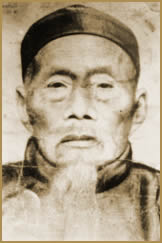 |
Kanryo Higashionna (1853-1915)
Grandmaster Kanryo Higaonna was born on
March 10, 1853 in Naha, the capital city Okinawa. His father,
Kanyo, worked as a merchant sailing between the small islands
of Okinawa trading everyday goods. From a young age, Kanryo
Higaonna helped his father in this work and through the hard
physical labor that was involved, he developed a strong body.
Kanryo Higaonna was still in his teens when his father died
suddenly. Kanryo decided he wanted to study the martial arts
and he set his heart on traveling to Fuzhou, China for this
purpose. In 1869, at the age of 16, he arrived in Fuzhou.
Once in Fuzhou, he studied the Chinese martial arts under
the great Master, Ryu Ryu Ko. He soon became "uchi deshi" (private
disciple) and he remained in China under the severe instruction
of his teacher for approximately 13 years. In addition to
studying empty handed martial arts, he also became accomplished
in weapons techniques and Chinese herbal medicine. Master
Ryu Ryu Ko esteemed his pupil highly and sanctioned Kanryo's
mastery of these arts - an honor which is accorded extremely
rarely. Such was Kanryo's skill in the martial arts that
his fame became widespread throughout Fuzhou and the surrounding
area.
In 1881, after 13 years of diligent study
with his teacher, he returned to Naha, Okinawa where his
martial arts became known as Naha-te- (these arts were also
referred to as "Tode" meaning martial arts from
China). Kanryo Higaonna taught these martial arts to the
people of Okinawa, and at the same time continued his own
research and practice. In order to teach the youth of Okinawa,
he developed a teaching method which was specifically designed
to develop the mind and body; and to improve both physical
and spiritual well-being.
In October 1905, when Kanryo Higaonna began
teaching at the Naha Commercial High School, it marked the
first occasion on which the previously secretive art of Naha-te
was "opened" to society in general.
When teaching, Kanryo Higaonna was an extremely
hard task master. However, in his everyday life, he was a
quiet and humble man and one who was renowned for his virtuous
character. He was a man who had no need or desire for worldly
things. He lead a simple life which was completely devoted
to the study and practice of the martial arts
Kanryo Higaonna's unparalleled skill in
the martial arts aside, his great and distinguished work
was in bringing the Chinese martial arts from China to Okinawa,
and there spreading these arts among the people of Okinawa.
Kanryo Higaonna is now bestowed with the
title, "Kensei (sacred fists) Higaonna Kanryo," a
title which is eminently fitting. His name is synonymous
with Okinawan martial arts and Naha-te, and his spirit is
destined to live on forever as a great and valued treasure
within Okinawan culture.
Kanryo Higaonna's whole life was devoted
to karate. He passed away in December 1915 at the age of
63.
|
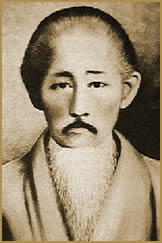 |
Chojun Miyagi (1888-1915)
Grandmaster Chojun Miyagi was born on April
25, 1888. In 1902, he began training in karate under Kanryo
Higaonna at the age of 14. Like his teacher before him, because
of his great natural talent and fierce determination, he
progressed very rapidly. The training was severe beyond belief
at times but he practiced ever harder with an enthusiasm
unmatched by any of the other students. Chojun Miyagi became "uchi
deshi" (private disciple) of Kanryo Higaonna. He studied
with his teacher for 14 years before his teacher's death
in 1915.
Chojun Miyagi, as successor to Naha-te pushed himself to
the limits of endurance in his desire to emulate the extraordinary
skills of his teacher. To this end, that same year (1915)
he journeyed to Fuzhou, China the city where his teacher
had studied the martial arts, to further his research. This
was one of three trips he made to China during his lifetime.
On his return to Okinawa, he began to teach
martial arts at his home in Naha. Later, he also taught at
the Okinawan Prefecture Police Training Center, the Okinawan
Master's Training College and at the Naha Commercial High
School where his teacher once taught.
Chojun Miyagi worked hard to spread karate
throughout Okinawa and mainland Japan, and to earn Naha-te
a status equal to that of the highly respected Japanese martial
arts of judo and kendo. To achieve this, he traveled frequently
to mainland Japan where he was invited to teach karate at
Kyoto University, Kansai University and Ritsumei Kan University,
respectively. In 1933, karate was registered at the Butokukai,
the center for all martial arts in Japan. This was a milestone
for karate as it meant that it was recognized on a level
with the highly respected martial arts of Japan.
Chojun Miyagi dedicated his whole life
to karate. He was responsible for structuring Naha-te (which
he later named "Goju-Ryu") into a systematic discipline
which could be taught to society in general. This teaching
system which he formulated, enabled karate to be taught in
schools for the benefit of the young, and to reach vast numbers
of people throughout the world. However, his private teaching
at his home remained strictly in adherence to the principles
and traditions of his teacher, Kanryo Higaonna, and his teacher
before him, Ryu Ryu Ko.
The naming of Goju-Ryu came about more
by accident than design. In 1930, Chojun Miyagi's top student,
Jin'an Shinzato, while in Tokyo was asked by numerous martial
arts masters as to what school of martial arts he practiced.
As Naha-te te had no formal name he could not answer this
question. On his return to Okinawa he reported this incident
to Chojun Miyagi. After much consideration Chojun Miyagi
decided on the name Goju-Ryu (hard & soft school) as
a name for his style.
This name he took from a line in the Bubishi
( a classical Chinese text on martial arts and other subjects).
This line which appears in a poem describing the eight precepts
of the martial arts, reads, "Ho Goju Donto" (the
way of inhaling and exhaling is hardness and softness).
|
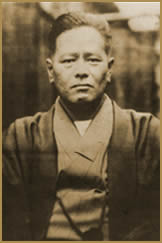 |
Jigoro Kano (1860-1938)
Kano Jigoro is the founder of the Japanese
martial art of judo..
Kano Jigoro was born to a sake brewing
family in Kobe, Japan. After entering the Tokyo Imperial
University he learned both Kito-ryū and Tenjin Shin'yo-ryū
jujutsu, two styles focused on different aspects of traditional
(koryū) fighting techniques.
In 1882, Kano founded the Kodokan, meaning "the
place for the study or promotion of the Way". Over time,
Kano was able to introduce his art to the Japanese school
system. His roles in Japan as an educator and the father
of modern sports in Japan are almost as famous as his founding
of judo.
Kano was a member of the the International
Olympic Committee (IOC) for Japan and lobbied for having
the 1940 Olympic Games held in Japan. He hoped that the games
would bring countries together and avoid war. In 1938, returning
from an IOC conference, Kano died of pneumonia aboard the
SS Hikawa Maru. His dream was finally realized in 1964 when
the Olympics were held in Tokyo and judo was introduced as
an Olympic sport.
|
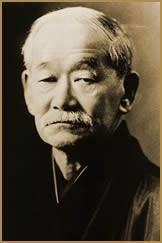 |
Founding Goju-Ryu Organizational Heads:
|
Seiko Higa (1889-1966)
Seiko Higa was one of Kanryo Higashionna
Sensei’s finest students. A contemporary of Chojun Miyagi
Sensei, he helped to preserve and spread the traditions of
Naha-Te. Higa Sensei was steadfast in his dedication to the
traditions, philosophy and the profound essence of Naha-Te.
Higa Sensei had a lasting impact in the development of the
modern Goju-Ryu system, and personally instructed many modern
Goju-Ryu masters.
Miyagi Sensei always gave Higa Sensei the respect he was
due. Higa Sensei later became vice-president and president
to some of the most prestigious societies to promote Karate-Do.
|
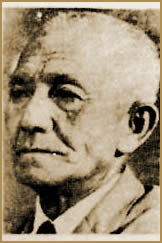 |
Gogen
Yamaguchi (1909-1989)
Meitoku Yagi was born in Naha, Okinawa,
on March 06, 1912. At the age of 14, Yagi Sensei began
training with Chojun Miyagi—the founder of Goju-Ryu Karate-Do. Miyagi
Sensei was always intrigued by his dedication to the art. While
other students learned a few katas directly from the founder,
Miyagi Sensei taught the entire curriculum to Yagi Sensei.
In 1952, after many years of direct supervision under the
founder, Yagi Sensei was given permission to open a dojo
in Naha, Okinawa. He called his dojo the Meibukan—House
of the pure minded warrior. After Miyagi Sensei’s death,
Yagi Sensei was given the founder’s gi and belt by the founder’s
family. Although his technique was taught directly
to him by the founder, Yagi Sensei saw a need to readdress
the Chinese influence in Goju-Ryu kata. The Meibukan
has certain differences with mainstream Okinawan Goju-Ryu
such as chambering in a vertical position rather than horizontal.
Yamaguchi Sensei passes away on February 07, 2003 |
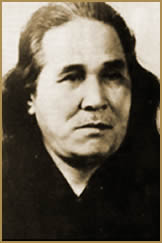
|
Meitoku
Yagi (1912-2003)
Meitoku Yagi was born in Naha, Okinawa,
on March 06, 1912. At the age of 14, Yagi Sensei began
training with Chojun Miyagi—the founder of Goju-Ryu Karate-Do. Miyagi
Sensei was always intrigued by his dedication to the art. While
other students learned a few katas directly from the founder,
Miyagi Sensei taught the entire curriculum to Yagi Sensei.
In 1952, after many years of direct supervision under the
founder, Yagi Sensei was given permission to open a dojo
in Naha, Okinawa. He called his dojo the Meibukan—House
of the pure minded warrior. After Miyagi Sensei’s death,
Yagi Sensei was given the founder’s gi and belt by the founder’s
family. Although his technique was taught directly
to him by the founder, Yagi Sensei saw a need to readdress
the Chinese influence in Goju-Ryu kata. The Meibukan
has certain differences with mainstream Okinawan Goju-Ryu
such as chambering in a vertical position rather than horizontal.
Yagi Sensei passes away on February 07, 2003 |
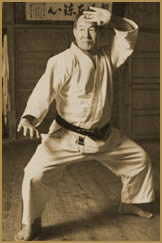
|
Seikichi
Toguchi (1917-1998)
Seikichi Toguchi was born on May
20, 1917, in Naha City, Okinawa. At the age of 15,
he began training directly under Seiko Higa Sensei, a student
of Chojun Miyagi Sensei. Before the founder’s death, Toguchi
Sensei was named executive director of the Goju-Ryu Association. Toguchi
Sensei was one of Miyagi Sensei's first senior students to
establish a school after the founder’s death in 1953. He
moved to Tokyo, Japan in 1960 and, in 1962, he established
the Shorei-Kai Meguro Dojo which later became the Shorei
Kan—House of politeness and Respect.
Toguchi Sensei was small in stature, but amazingly strong
with a compact and powerful body. His methodology
and training principles are still taught today in many parts
of the world. Toguchi Sensei died on August 31, 1998.
|
|
Eiichi Miyazato (1922-1999)
Eiichi Miyazato Sensei was born
on July 05, 1922, in Naha, Okinawa. After being introduced
to Karate-Do by his father, Miyazato Sensei began formal
studies with Chojun Miyagi Sensei—founder of Goju-Ryu Karate-Do. At
an early age, Miyazato Sensei showed an aptitude for both
Karate-Do and Judo. By 1946, he joined the Ryukyu Police
Department upon the recommendation of Miyagi Sensei.
After the death of Miyagi Sensei in 1953, Miyazato Sensei
began teaching Goju-Ryu Karate-Do at the founder’s garden
dojo. In 1957, Miyazato Sensei opened the famous Jundokan
dojo in Naha, Okinawa. And, in 1970, he opened the
permanent home of the Jundokan.
Miyazato Sensei died on December 11, 1999. He was a
tremendously gifted karateka and Judoka. The Jundokan
continues to operate 24 hours a day in its present location,
always open to those who want to train.
|
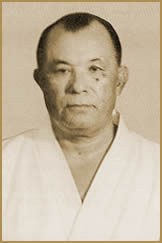
|
Modern Founders and Masters:
|
Morio Higaonna (1938 - )
Morio Higaonna Sensei was born on December
25, 1938. At the age of 14, Higaonna Sensei came to
train at Miyagi Sensei’s dojo. As a youngster, Higaonna
Sensei became extremely attached to A’nichi Miyagi Sensei
whom he credits as his mentor and teacher. When he
arrived in Tokyo, Japan at the age of 22, he was already
an accomplished martial artist. At 22, he was
invited to teach at the Yoyogi Dojo in central Tokyo. By
all accounts his classes were severe, but extremely popular.
Higaonna Sensei possesses superb technique and incredible
power. His classes are extremely demanding, truly testing
the limits of human endurance; yet he is characterized as
fair and humble. In 1979, Higaonna Sensei formally
left the Jundokan and established the International Okinawan
Goju-Ryu Karate-Do Federation (IOGKF). Under his direction,
the IOGKF is now established in 50 countries with more than
30,000 members worldwide.
In September 1987, Higaonna Sensei moved
to the United States, and two months later, opened the Institute
of Traditional Karate (hombu for the IOGKF) in San Marcos,
California
|
|
Teruo
Chinen (1941 - )
Teruo Chinen Sensei was born on June 08,
1941 in Kobe, Japan. By the late 1940’s, he arrived
at the doorstep of Chojun Miyagi Sensei. After the
founder’s death in 1953, Chinen Sensei began training with
Miyagi Sensei’s senior student Seiichi Miyazato. As Miyazato
Sensei’s ueshi deshi—private student, he began to further
develop his Goju-Ryu skills.
After teaching alongside Morio Higaonna Sensei at the Yoyogi
Dojo in Tokyo, Japan, Chinen Sensei continued to research
Goju-Ryu Karate-Do, and traveled regularly to China for additional
research. Chinen Sensei then left Japan for good in
1969, and settled in the United States. In 1986,
he formed the Jundokan International named in honor of his
teacher Seiichi Miyazato Sensei.
Chinen Sensei continues to actively teach
based out of his hombu in the State of Washington. |
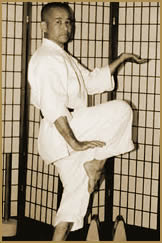
|
Founders in America:
|
Peter
Urban (1934 - 2004)
Peter Urban was born on August 14, 1934
, in Jersey City, New Jersey. In 1952, he enlisted in the
Navy where he became a decoder. In 1953, while serving in
Yokohama, Japan, he started his apprenticeship under the
late Master Richard Kim. He became Master Kim's "Uchi-deshi" house
student. In 1954, Master Kim introduced Urban to Master Gogen
Yamaguchi of Tokyo Japan.
In 1955, he was introduced to Master Masatatsu Oyama, also
in Tokyo, Japan, and becomes a full time student of Master
Oyama. In 1956, Young Sensei Urban teaches the 212th "MP" Military
Police Corps in Tokyo Japan. In 1957, Sensei Urban was chosen
by the Late Master Yamaguchi to compete in the first all
Japan Collegiate Championships in Tokyo. In 1958, Sensei
Urban was again chosen to participate by Master Yamaguchi;
this time at Chuo University where he fights the captain
of the Chuo University Karate team. In 1959, he departs from
Japan and establishes his first Goju-Ryu Dojo- school at
14th St. Union City, New Jersey. At the time, he also had
a dojo at the Hoboken YMCA, where he would teach on week-ends.
At the end of 1960, he taught Goju-Ryu at a dojo that belonged
to the Judo twins. He then establishes his first Goju-Ryu
Dojo in New York at 20 East 17th St. This is where Master
Urban founded The American Goju-Ryu Karate Assoc.
Peter G. Urban, a Greek-American, was truly
a pioneer of the martial arts. He is widely regarded as the
father of American Karate. While training in Japan, he learned
from three of karate’s greatest masters—Gogen Yamaguchi,
Masutatsu Oyama, and Richard Kim, respectively. In 1959,
he opened his first karate academy in Union City, New Jersey.
Later, he opened his famous Chinatown Dojo in New York City,
first at 213 Canal Street, and later at 1 Crosby Street.
He was responsible for the development
of some of the great Goju-Ryu stylists of the era. These
individuals include: Edward Verycken, Frank Ruiz, Harry Rosenstein,
Ronald Taganashi, Joseph Hess, Johnny Kuhl, Ric Pascetta,
Claudio Gonzalez, Gerald Orange, and many others. Furthermore,
he had a hand in the development of many organizations including:
The United States of America Goju Association (USAGA), Nisei
Goju-Ryu, The World Sansei Goju-Ryu Karate Organization,
Hispanic Goju, Kanzen Goju, and Neko-Do Goju-Ryu.
In addition, he allowed the formation of
different entities within American Goju. Thus, it is my opinion,
and the opinion of many others, that American Goju-Ryu is
truly "America’s indigenous style." Although there
are many such styles in the United States, "American
Goju is America’s system." Along with his vision, he
was instrumental in revolutionizing Karate. He is America’s
first 10th Dan, in addition to introducing the black uniform—gi,
the iron-wall defense, and the famous grab and punch attack.
Moreover, he introduced the American Taikyoku, the American
Empi-Ha--the most beautiful form ever created, and the Urban
Kururunfa to the Goju-Ryu curriculum. We are all indebted
to the vision of this great pioneer. He continues to be the
Grand Patriarch of All American Goju-Ryu Karate Systems.
|
|
Chuck
Merriman (1933 - )
Chuck Merriman Sensei began his martial
arts training in 1960. He first studied Judo and then
began Karate in 1962. Throughout his competitive career,
Merriman Sensei excelled in all facets of Karate. He
was nationally rated in kata for much of his career. Widely
regarded for his extensive expertise on the Goju-Ryu system,
he continues to amass an impressive resume.
Merriman Sensei has studied with Peter G. Urban Sensei, Seiichi
Miyazato Sensei, and Iha Koshin Sensei, respectively. He
has personally coached in both traditional and open karate
events producing numerous champions.
Most recently, Merriman Sensei is the highest
ranking American in the Jundokan organization. He
has been graded a 9th dan by said organization.
|
|
Edward
Verycken (1940 - )
Grandmaster Edward Verycken is a true
legend of American Goju-Ryu. According to Maestro Peter Urban,
Verycken Sensei was his first student in the Union City,
New Jersey dojo, circa 1959. Furthermore, according to Maestro
Urban, Verycken Sensei was also his first black belt. He
was subsequently promoted to Judan—10th degree black belt
by Maestro Urban, and is the founder of Neko Ashi Ryu. In
addition, he personally taught, trained, or supervised some
of the greatest Goju karatekas of the east coast.
A career law enforcement officer, he is singularly responsible
for many of the modern-day restraining and defense tactics
taught at police academies nationwide.
After decades of teaching and propagating,
Verycken Sensei retired from active teaching duties, and became
a deacon in the Catholic Church. He continues his duties in
the church, and teaches privately on occasion to top black
belts. Verycken Sensei lives in New Jersey, and it is our intention
to recognize his contributions and legacy to American Goju-Ryu.
The following excerpt is from Grandmaster
Claudio Gonzalez, and it is reprinted with his permission:
“Verycken Sensei, was the toughest and most disciplined sensei
I ever had; a no nonsense sensei. He was a dedicated kata man,
excellent coordination in kumite, and techniques executed with
perfection. And most of all…absolutely the best “tamashewari”-breaking-man
I have ever seen. Verycken Sensei could break anything with
his fists or feet; truly, a necessary part of Karate that has
been almost all lost. Honestly, he is DEFINITELY the best breaker
I have ever seen. A real old-fashioned classical sensei. He
was my second father. His Karate knowledge, discipline, and
(pain) influence in my life was life changing and life-long.” |
|
Frank
Ruiz (1935 - 1995)
Frank Ruiz, the founder of Nisei Goju-Ryu
was a legend. Not only was he considered a true tough-guy
of karate, but was also instrumental in the development of
many of the great east-coast fighters.
Hanshi Ruiz, a student of Peter Urban, was an avid tournament
competitor in the early nineteen-sixties. One of the fierce
fighters of his time, Hanshi Ruiz secured
titles at the Gheez Nation Championships-1963, U.S. International
Championships-1964, and undefeated in 186 fights. He would
later, in 1969, come out of retirement to take the Pan American
Kata Championships in Puerto Rico.
He was small in stature, but epitomized
the notion of tenacity, and fierce determination. As a fighter,
he had few rivals, but his greatest legacy was his sincerity.
As a young man, I spent many hours conversing
with this legend. I viewed him as a father figure, and a gentleman.
We had in depth conversations about rank, loyalty, and the
future of the art.
Although he is now deceased, he will never
be forgotten by any of us. He is sorely missed. |
|
Manny
Saavedra (1951 - )
Manny A. Saavedra is the founder of the
World Sansei Goju-Ryu Karate Organization. During the last
20 years, his organization has expanded into many parts of
the world.
Based out of his headquarters in New Jersey, Hanshi Saavedra
is one of Goju-Ryu’s great technicians. He is well-versed
in many manifestations of the art, including the American
style and traditional motifs. He is a researcher, philosopher,
and a life-long student of Goju-Ryu. Hanshi Saavedra has
taught at the university level in both New York and Florida.
Additionally, he has served as past president
of the Inter-Collegiate Karate Association, and has been
instrumental in the development of a martial arts curriculum
for college credit.
On a personal note, I love and respect
this man for his friendship throughout the years. I consider
him a personal mentor, and to this day, value his opinions
and guidance with respect to life and our organization. We
converse on a daily basis to this day.
Time will prove what I already know; Mr.
Saavedra is a great man and a true technician. |
|
Claudio
Gonzalez (1952 - )
Grandmaster Claudio Gonzalez is a native
of Cuba born in 1952. Upon his arrival in New Jersey with
his parents, they settled in Union City. Gonzalez Sensei
began his martial arts studies in the mid-1960’s in the art
of Jiu-Jitsu. Shortly thereafter, he switched to USA Goju
under the tutelage of Grandmaster Edward Verycken. While
still in his teens, he attained his black belt—Shodan—in
1968. Moreover, he began teaching students the training and
philosophical aspects of American Goju-Ryu in early 1969.
In the early 1970’s, Gonzalez Sensei began training directly
under the tutelage of Maestro Peter Urban. He studied extensively
with Maestro Urban attaining his Sandan—3rd degree black belt
in 1973 at the famous Chinatown Dojo (New York City) at 1 Crosby
Street. It was there that he met the likes of Ron Van Clief,
Joseph Hess, Ric Pascetta, Gerald Orange, and other notable
Goju practitioners. In July 1984, he was promoted to Judan—10th
degree black belt by Maestro Urban.
Gonzalez Sensei taught extensively for almost 3 decades,
and has influenced either directly or indirectly thousands
of Goju-Ryu practitioners in New Jersey and Florida. As
a teacher, he is second to none. As a fighter, he is extremely
powerful, blessed with exceptional speed, and posseses
immaculate technique. Now over 50 years old, he is still
in phenomenal physical condition. Although he is no longer
actively teaching scores of practitioners, he still practices
kata daily, and routinely bicycles hundreds of miles a
week.
Additionally, Gonzalez Sensei fulfilled
his career vocation when he joined the Union City Police
Department. He worked 12 years as an undercover officer in
the bowels of the city. His extensive training has kept him
alive in numerous life-threatening situations, including
handgun and knife attacks. In his illustrious career, while
rising through the ranks of the police department, he has
personally supervised uniformed patrolmen and detective bureau
personnel as well. Presently, Gonzalez Sensei is retired
from the Union City Police Department with the rank of Inspector.
Gonzalez Sensei is a highly educated,
and spiritual man. He is happily married to wife MaryEllen,
and has two beautiful children.
|
|
Yoshisada
Yonezuka (1940 - )
Grandmaster Yoshisada Yonezuka is the
head of the prestigious Cranford Judo and Karate Center of
central New Jersey. “Yone,” as he is affectionately referred
to, is a career martial artist. As a young man in 1955, Yonezuka
Sensei won the Northern Japan High School Championships after
only one year of formal practice.
Later that year, after defeating six Shodans—1st degree black
belts at the Kodokan, he was promoted to Nidan—2nd degree black
belt. In 1956, after entering Kihon University, he defeated
nine Nidans—2nd degree black belts at the Kodokan, thus earning
his Sandan—3rd degree black belt. In 1959, Yonezuka Sensei
was the northern Japan Judo Champion.
In 1960, Yonezuka Sensei began teaching
Judo in New York City. He remained in that capacity until
1962. In 1962, he also taught at West Point, and opened his
famous Judo and Karate Center.
Throughout the better part of 4 decades,
Yonezuka Sensei has won numerous championships in the Masters
division, and has personally trained some of America’s greatest
Judokas. He has trained national, pan-American, International,
World, and Olympic champions. These champions include: Allan
Coage, Mitch Santa-Maria, Nicholas Yonezuka, Clyde Worthen,
and Michael Swain—America’s all-time greatest Judo competitor.
In addition, Yonezuka Sensei has coached
two-Olympic teams, and multiple world teams in Judo and Sumo.
He presently resides in central New Jersey, and still runs
the Cranford Judo and Karate Center. In addition, he is an
8th degree black belt—Hachidan in Judo and Karate. He is
truly a living legend of the art.
Dr. Gallego trained with this great master
in the mid-1970’s, and considers him his only Judo teacher.
Neko-Do Systems Goju-Ryu International recognizes the contributions
of this great man to the development of Judo. |
|
Philip
Porter (1925 - )
O’Sensei Philip Porter began his martial
career in boxing, circa 1943. While at West Point, he won
a USAF light-heavyweight boxing title. In 1951, Porter Sensei
began his formal martial arts training in Judo, Jiu-Jitsu,
and Karate under Grandmaster Walter Todd.
After graduating from West Point in 1948, he served in the
United States Air Force for 20 years, retiring with the rank
of Major.
After almost 7 decades of service, Porter
Sensei is widely regarded as the “Father of American Judo.”
From the Armed Forces Judo Association, he formed the United
States Judo Association in 1954. He has served American Judo
in many capacities, especially from a leadership perspective.
In addition, he is one of the most respected martial artists
in the world. He has a Judan—10th degree black belt in Judo,
as well as high ranks in Jiu-Jitsu, and Karate.
After almost three decades as leader of
the USJA, Porter Sensei retired from that capacity, and presently
chairs the United States Martial Arts Association—USMA. He
is revered as a leader, but also as a trainer, coaching over
1,000 national and international medalists.
Dr. Gallego is honored to call him “friend.”
In addition, Neko-Do Systems Goju-Ryu International pays
homage and respect to this great pioneer, and martial artist.
Presently, Dr. Gallego holds a Shichidan—7th degree black
belt in Judo and Ju-Jitsu under his supervision. |
|
Bert
Becerra (1950- )
Instructor Bert Becerra is a seventh degree
black belt in judo and a seventh degree black belt in jujitsu,
spending years training and competing internationally. Becerra
spent time teaching at the N.J.I. (National Judo Institute)
in Colorado Springs, where he still teaches every summer.
After several years of teaching at the N.J.I., he was invited
to train/teach at the Kodokan in Japan (the official school
for Judo in Japan). Becerra spent 15 years in Japan in his
earlier years. While there, he trained in various martial
arts.
He earned a 5th Dan in Shotokan Karate.
Mr. Becerra currently teaches Jujitsu at Richland Junior
College in Dallas, TX., and has his own Judo Club. He's the
head instructor of the Becerra Judo & Jujitsu Club in
the Dallas suburb of Garland, TX. Becerra is a member of
the International Black Belt Hall of Fame in Pittsburgh,
PA, and recently received their Pinnacle Award for Success.
Becerra is a certified instructor in sexual
harassment, assault and rape prevention for women by PPCI
Management Systems, Inc. & The Institute for Control & Restraint
Research, Inc.
He is a certified professional consultant
and speaker on child safety and danger awareness from the
National Security Alliance. He also frequently holds seminars
and workshops on grappling. |
|
| |
|
|
| |
 |
| |
|
|
 |
| |
 |
|